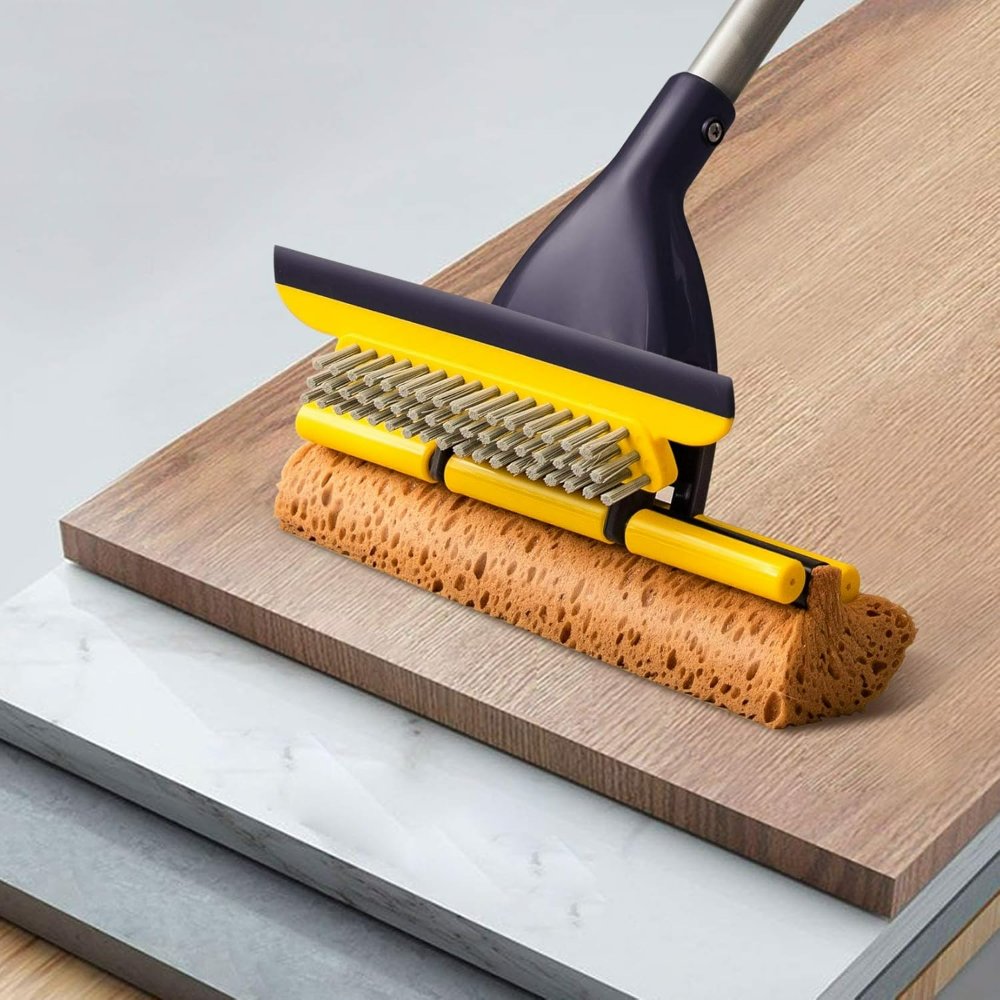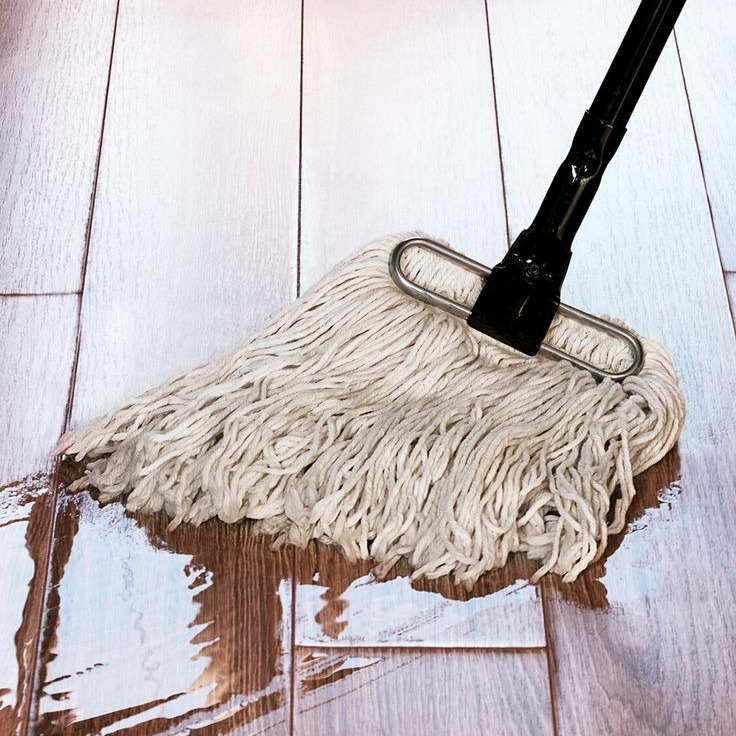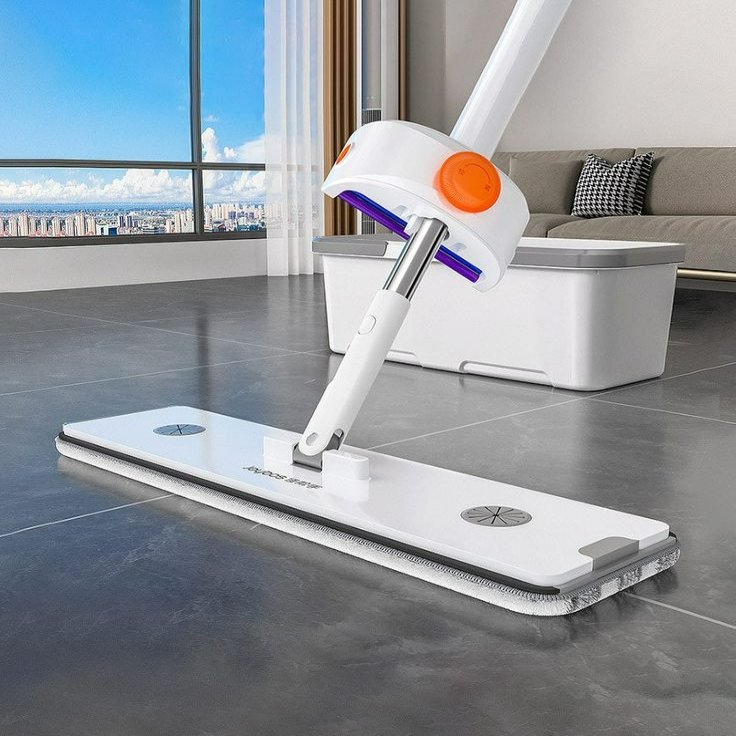Essential Mopping Supplies
To mop like a pro, you need the right tools.
Choosing the Right Mop
- Flat mops work well for tight spaces and maintain contact with the floor.
- String mops offer traditional cleaning and can reach into corners.
- Sponge mops are best for smooth surfaces and easy wringing.
- Microfiber mops pick up fine debris and are perfect for hardwood and laminate.
Consider your floor type when selecting a mop.
Selecting the Best Cleaning Solution
The cleaning solution should match the flooring material.
- For hardwood, pick a pH-neutral solution to prevent damage.
- Laminate floors require mild detergent to avoid streaks.
- With tile, you can use stronger solutions for deep cleaning.
Make sure to dilute the solution according to the manufacturer’s instructions to avoid over-wetting the floor.
Always test a small area first to ensure no discoloration or damage occurs.

Preparing the Floor for Mopping
Before you start mopping, preparation is key to effectively clean your floors.
Clearing the Area
Start by removing any furniture, rugs, and obstacles from the area. Clearing the space allows you to mop without interruption. Pick up any large debris by hand to prevent them from spreading during mopping.
Sweeping or Vacuuming
Next, sweep or vacuum the floor to remove dust, hair, and smaller particles. This step is crucial because mopping directly over debris can cause scratching. For carpets, use a vacuum; for hard surfaces, a broom or vacuum will work. Ensure that the floor is free of loose particles to pave the way for a smooth mopping experience.
Mopping Techniques
To achieve clean floors, mastering various mopping techniques is crucial.
Wet Mopping
Wet mopping is the most common method for deep cleaning floors. Start by soaking your mop in the cleaning solution. Ensure it’s not dripping wet to avoid excess water on the floor. Begin mopping from a corner, working backwards towards the door to avoid stepping on wet areas. Use overlapping strokes to cover the entire surface. Change the water when it gets dirty to prevent spreading grime.
Dry Mopping
Dry mopping, or dust mopping, is ideal for picking up dust and hair before wet mopping. It involves a dry microfiber or cloth mop. Start from one corner of the room and move to the other side, using a figure-eight pattern to trap particles effectively. Dry mopping can also be a quick daily cleaning method to keep floors tidy between wet mopping sessions.
Spot Cleaning
Sometimes spills and stains need immediate attention. This is where spot cleaning comes in handy. Immediately clean up spills to prevent staining. For spot cleaning, apply cleaning solution directly to the stain and gently scrub with a mop or cloth until the stain lifts. Rinse the area with a clean, damp cloth to remove any cleaning residue.
The Mopping Process
To get the best results, a proper mopping process is essential. Each step plays a crucial role in the overall cleanliness of your floor. Here’s how to execute the process effectively:
Soaking the Mop in Solution
Begin by soaking your mop. Dip it into the cleaning solution until it’s fully saturated. Don’t rush this step. A well-soaked mop picks up more dirt. But, remember to squeeze out excess liquid. Too much water can harm your floors, especially if they are wood or laminate.
The Correct Way to Wring Out a Mop
After soaking, it’s time to wring out your mop. Do this firmly but gently. The aim is to leave it damp, not wet. A good wringing prevents water from pooling on the floor. Pooling can lead to water damage or slips. Twist or compress your mop according to its type.
Mopping Patterns and Strategies
Effective mopping requires a pattern. This ensures you cover the entire floor. Use the figure-eight pattern for efficiency. It reduces strain on your arms and ensures that dirt and debris are not spread around. Start from the farthest corner and work backward toward the door. This strategy keeps you from walking on the clean floor. For large areas, divide the floor into sections. Clean each one before moving to the next.

Avoiding Common Mopping Mistakes
Even with the best techniques, a few common errors can make mopping less effective. Avoid these to maintain pristine floors.
Over-Wetting the Floor
Avoid soaking your floors with too much water. Especially on hardwood and laminate, excess moisture can cause damage. Use a damp mop, not a drenched one. Change the water once it looks dirty, so you don’t spread dirt around.
Ignoring the Corners and Edges
Dust and dirt often hide in corners and along edges. Don’t overlook these spots. Use a specific technique, like angling the mop, to clean them thoroughly. This ensures a complete clean across the entire floor area.
Mopping with Dirty Water
Using dirty water just moves the grime around. Change the mop water as soon as it’s visibly dirty. This prevents dirt from getting back onto the floor, ensuring a cleaner end result.
Caring for Your Mopping Equipment
To keep your floors shining, caring for your mopping equipment is essential.
Cleaning Your Mop After Use
After you mop, it’s vital to clean your mop properly. Begin by rinsing the mop head under hot water. Use a brush to remove any stuck dirt. For a deeper clean, soak the mop head in a mixture of water and mild detergent for 10 minutes. Rinse it again. Squeeze out as much water as possible, and hang the mop head to dry completely. This prevents mold and bad odors.
Proper Storage of Mop and Bucket
Storing your mop and bucket correctly will extend their life. Always empty the mop bucket and rinse it with clean water. Dry it thoroughly to avoid mildew. Hang the mop so the head does not touch the ground. This keeps it from getting deformed. Store the bucket in a cool, dry place. Make sure it’s upside down to keep dust out.

Additional Tips for Mopping Different Types of Floors
Different floor types require specific care to maintain their beauty and longevity. Applying the right mopping tips can prevent damage and ensure a thorough clean.
Hardwood Flooring
Hardwood floors need gentle, yet effective cleaning methods. Use a pH-neutral cleaner and avoid pooling water to prevent warping. After wet mopping, go over with a dry mop to remove excess moisture. This step upholds the wood’s integrity and shine.
Laminate Flooring
For laminate floors, minimal water is key to preventing swelling. Use a damp (not wet) microfiber mop paired with a gentle cleaner. Mop in sections and immediately dry the area to stop streaks from forming. Regular care keeps laminate looking new.
Tile and Stone Floors
Tile and stone floors can handle more vigorous mopping. Feel free to use stronger solutions, but rinse thoroughly to prevent residue build-up. For textured tiles, use a brush to get into the grooves and remove trapped dirt. Proper techniques will keep these floors sparkling.
When to Call in the Professionals
At times, mopping might seem like a straightforward task, but instances arise when calling in professional floor cleaning services is the best option.
Benefits of Professional Floor Cleaning
Professional cleaning comes with perks that go beyond a simple mop job. Here’s what you gain from hiring experts:
- Deep clean: They have the equipment and expertise to deeply clean floors, reaching dirt that regular mopping misses.
- Time-saving: Professionals clean efficiently, giving you more time for other activities.
- Longevity of floors: Regular professional cleanings can extend the life of your flooring.
- Advanced techniques: Experts use techniques that might not be widely known or accessible to the public.
- Convenience: It’s a hassle-free way to maintain cleanliness, especially for large or high-traffic areas.
- Specialized care: Different floors need different care, and professionals know exactly what to use and how to use it.
Incorporate professional cleaning occasionally to ensure your floors stay pristine.
Signs That You Need Expert Cleaning Services
- Stubborn stains: If stains won’t budge, it’s time to call the pros.
- Dull appearance: Floors that lost their shine might need a professional touch.
- Allergies: Persistent dust or allergens, despite cleaning, call for expert service.
- Special events: Prior to hosting a major event, getting professional cleaning ensures spotless floors.
- Post-renovation: Post-construction dust and debris require professional equipment to fully clean.
- Business spaces: High-traffic business areas benefit from the thorough cleaning standards of professionals.
Consider these signs as indicators that your mopping efforts could be supplemented with professional expertise to maintain optimum floor cleanliness and appearance.